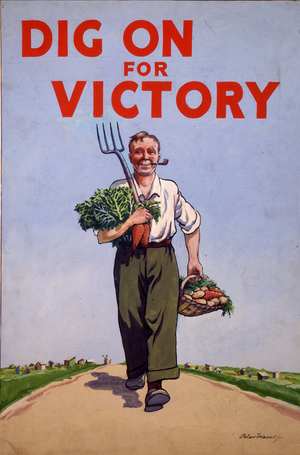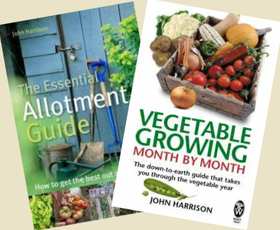This dig for victory guide on bottling and canning fruit and vegetables gives good basic information on the subject. It’s a guide that you would have expected from the Ministry of Food but they were a little slow to get going on the advice front. Once Lord Woolton took over as Minister of Food from W S Morrison in April 1940, the Ministry of Food quickly caught up.
Originally this was a 2 page, 4 side leaflet but it fits well onto one web page.
The original leaflet (This is the September 1941 copy) covered both canning and bottling but by the August 1943 version it purely covered bottling (see explanation under canning) & Bottling Fruit and Vegetables
BOTTLING AND CANNING FRUIT AND VEGETABLES
DIG FOR VICTORY LEAFLET No. 11
MOST fruits can be bottled or canned. Particularly suitable are apples, apricots, cherries, damsons, gooseberries, loganberries, plums and rhubarb. Strawberries are not satisfactory, as they lose colour and shrink during sterilization. Of pears, only dessert varieties should be chosen, and the fruit must be ripe.
With the exception of gooseberries, which are used green and hard, the fruit should be just fully ripe but not over-ripe.
BOTTLING FRUIT
Grading and Preparation
The fruit should be carefully graded for size and ripeness so that it will cook evenly.
Rinse in cold water and prepare as for other cooking purposes. The fruit should be packed to the top of the bottle and as tightly as possible without damaging it.
Bottles
Clip-top or screw-band preserving bottles of the vacuum type should be used if possible. Clip-top bottles, in the 26 oz. size, are recommended as being cheap and suitable for most kinds of fruit.
Preserving bottles are fitted with lids and rubber rings to keep them air-tight.
The lids of clip-top bottles are held in position by the clips during sterilization and cooling, but screw-band lids should have the bands loosened slightly during the sterilizing process and tightened immediately the bottles are removed for cooling.
If vacuum bottles are not available, ordinary jars may be used provided they are covered with an air-tight seal. Three or four layers of greaseproof paper dipped in egg-white, gum or paste ; or a well-fitting cork ; or a piece of cloth painted with a circle of wax, specially prepared from rock resin (8 oz.), vaseline (1 oz.) and beeswax (1 oz.), can be used.
Jars with these home-made seals are not suitable for immersing in a sterilizer, but either of the other methods of sterilization described below may be used.
The synthetic skins now on the market are also recommended ; jars covered with these can be immersed in water to sterilize.
Syrup
The fruit may be bottled in water or syrup ; the latter keeps the flavour of the fruit better. The syrup is prepared by dissolving 4 Ib. sugar in 1 gallon water, bringing it to the boil and straining through muslin before use.
Sterilization
Fruit may be sterilized for bottling in any of the following ways :—
In a Sterilizer.
Any deep vessel, such as a fish-kettle, fitted with a fake bottom, can be used if the temperature can be regulated. After filling the bottles with fruit and cold syrup or water, the lids and clips are put on, or if screw-bands are used, these are fitted but not screwed tight.
They are then placed in cold water and heated gradually for 1½ hours until the temperature indicated for the various fruits in the Table below is attained. This temperature should be held for the time shown in the Table.
| FRUIT | RAISE TO ºF. In 1½ hrs. |
MAINTAIN FOR (Minutes) |
|---|---|---|
| Apples, Apricots, Blackberries, Damsons, Gooseberries, Loganberries, Plums (ripe, whole), Raspberries, Rhubarb, Strawberries |
165 | 10 |
| Plums (halved or unripe) | 165 | 20 |
| Currants | 180 | 15 |
| Cherries | 190 | 10 |
| Pears and Quinces | 190 | 20 |
| Tomatoes (covered with brine, made from ½ oz. salt to 1 qt. water. About ¼ oz. sugar may be added if desired) |
190 | 30 |
The bottles should be removed, placed on a wooden table, the screw-bands tightened, and left to cool.
In an Oven.
The containers of fruit, without the liquid, are placed on asbestos mats in a moderate oven (at about 250° F.) and heated until the fruit appears cooked (about ¾-1 hour). They are then filled with boiling water or syrup and sealed immediately.
In a Saucepan.
The fruit is stewed until it is cooked with sufficient water or syrup to prevent burning, poured while still boiling into hot bottles, and sealed immediately. As an extra precaution, the bottles as soon as filled are put into a pan of hot water (standing them on a false bottom) and boiled for 5 minutes.
Testing the Seal
When the bottles are cold, the screw-bands or clips are removed, and each container lifted carefully by its lid to test the seal. If the lid remains firm there is a good vacuum, but if it comes off there is a fault in the seal.
Canning Fruit
Canning (in the British use of actual metal cans rather than re-useable bottles) enjoyed some popularity at the start of the war after the USA shipped a number of canning machines which were required to seal the cans and the cans themselves.
As the U boat offensives increased and imports became more constrained, emphasis was given to bottling which can be done without special equipment and utilising re-useable glass bottles. Glass is more easily recycled as well. The metal industries were better utilised in making military equipment and munitions than food storage tins.
Canning, on a domestic scale, also has a higher failure rate than bottling – resulting in spoilt food.
Size 2½ cans are recommended, and a special sealing-machine is necessary for closing the cans.
The cans are filled with fruit and boiling syrup or water to within ¼ in. of the top, sealed immediately, and placed in boiling water. The length of time for sterilization depends on the type of fruit and the time taken for the water to come to the boil again. These are indicated in the Table below.
| FRUIT | TIME TAKEN FOR WATER TO REBOIL (Minutes) |
ADDITIONAL TIME FOR CANS TO BE KEPT IN BOILING WATER (Minutes) |
|---|---|---|
| Apples (in syrup), Apricots, Blackberries, Damsons, Gooseberries, Loganberries, Plums (firm-ripe), Raspberries, Red Currants, Rhubarb, Strawberries |
0 – 5 6 -10 11 – 15 16 – 20 |
15 – 18 13 – 15 10 – 12 8 – 10 |
| Apples (solid-pack),* Blackcurrants, Cherries, Pears (ripe dessert), Plums (under-ripe) | 0 – 5 6 -10 11 – 15 16 – 20 |
20 – 22 18 – 20 15 – 17 13 – 15 |
| Tomatoes (in brine) | 0 – 5 6 -10 11 – 15 16 – 20 |
32 – 35 30 – 32 27 – 30 25 – 27 |
| Tomatoes (solid-pack)* | 0 – 5 6 -10 11 – 15 16 – 20 |
42 – 45 40 – 42 37 – 40 35 – 37 |
| * Solid-pack Apples and Tomatoes should be canned while still hot from blanching |
||
BOTTLING AND CANNING VEGETABLES
Vegetables may be heavily contaminated with soil organisms, which often include the most heat-resistant forms of bacteria, and unless these are ‘killed during sterilization they may cause spoilage of the vegetables in the bottle or can. Bottling or canning of vegetables is therefore recommended only if an autoclave or pressure cooker that can be kept at 10 lb. steam pressure is available.
Suitable Vegetables
Asparagus, beans and peas, carrots, celery and spinach.
Preparation
Wash and prepare as for other culinary purposes. Grade for size and colour, and blanch by immersing in boiling water for a short time and then dipping in cold water.
The vegetables are packed into the bottles or cans and covered with boiling brine (2-3 oz. salt in 1 gallon water).
The cans are then sealed down or lids fixed on the bottles.
Sterilization
This should be done immediately after sealing, the instructions supplied by the makers of the pressure-cooker being strictly followed. Times for sterilizing vary from 25 to 75 mins, at 240° F. according to the kind of vegetable.
Note, A fuller account of methods of preservation is given in ” Preserves from the Garden ” (” Growmore” Bulletin No. 3). Price 4d., by post 5d. Obtainable through a bookseller or from H.M. Stationery Office, York House, Kingsway, London, W.C.2.
Issued by the Ministry of Agriculture and Fisheries, Hotel Lindum—St. Annes -on- Sea—Lancashire.
September 1941


